History
Manhattan, Kansas has had a tax-supported Municipal Band since 1920 when the city adopted a tax levy for that purpose. The band played its first concert on the lawn of the Riley County Courthouse. Over the years the band's membership has come from all conceivable walks of life, including students, staff, and faculty from Kansas State University, Manhattan Christian College and surrounding public schools, as well as military and civilian personnel from nearby Fort Riley, representatives of the community's diverse private sector, clergy, and retirees.
On April 1, 1919, in response to a petition with 250 signatures submitted to the City Commission by sixteen-year-old Charles ("Charlie") Moorman, the people of Manhattan, Kansas voted 1218 to 695 to levy a tax of 2/10 mill to create a Municipal Band Fund. On January 6, 1920, The Manhattan Daily Nationalist announced that the Manhattan Municipal Band would begin its first season, under the direction of Mr. Burr Ozment.
The band's first contract with the City of Manhattan, signed March 9, 1920, stipulated that it would perform one concert in each of the winter months and a total of seventeen concerts during the summer. Four months later, the city appropriated money to ensure that the then sixteen-piece band would be available to perform year-round concerts. The winter concerts were to be held in the Community House, still at the corner of Fourth Street and Humboldt Avenue. After some contention regarding the expectations and necessity of the winter concerts, the contract renewal for the 1922 season a series of twenty-five performances was decided upon, opening on Decoration Day and closing on Armistice Day. The idea of off-season concerts came up from time to time for several years with little success, but was finally abandoned in 1949 due to their impracticality. The typical contract on which the band and the city seem to have settled upon by the mid-point of the century provided for not less than ten weekly concerts, free and open to the public, with the possibility left open for further concerts deemed necessary for "worthy civic enterprise where their services might be needed."
In 1937, Harry Brown, by then the second director of the band, elected to form a board of control to handle matters of policy and finance and to assist in the overall operations of the organization. The first Board of Control consisted of three members: Lyle Downey (chairman), Director of Bands at Kansas State College and baritone horn player in the municipal band; Clarence P. Howenstine (assistant conductor), local businessman and baritone horn player in the municipal band; and Donald Parrish (secretary), chemistry teacher at Manhattan High School and later at Kansas State College and clarinet player in the municipal band.
Directors
| Burr Ozment | (1876-1943), Director 1920-1921 | | |
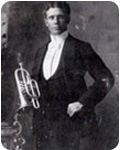 Burr's Bio Burr's Bio
Burr Ozment was a cornet player from a farming family near Carthage, Missouri. From 1899-1902 he attended Baker University in Baldwin, Kansas, where was actually both a student and the band director. His reputation apparently preceded him so much that in 1903 Dr. Richard Henry Jesse, president of the University of Missouri in Columbia, urged him to come there to continue his music studies and direct the university's band. He was enrolled in 1903, and while he never actually graduated, he remained there as an instructor through the 1910-11 school year. In the fall of 1911, Ozment moved to Manhattan to direct the band at Kansas State Agricultural College (KSAC). In November of the following year he announced his wishes to organize a city band. In 1917, he and the ROTC Cadet Band of KSAC enrolled as a unit in the United States Marine Corps for four years. While the members of the unit remained in for their full enlistment, Ozment was discharged after only fourteen months due to a heart ailment. His interest in directing a band did not diminish, however, and while working for the Quartermaster Corps at Camp Funston, Fort Riley, the focus of Ozment's interests led to the passage of the band law in Manhattan and his assumption of the podium of the Manhattan Municipal Band. When the United States Army closed Camp Funston Ozment's employment through Fort Riley was terminated, and on October 4, 1921 Burr Ozment resigned his position as conductor of the Manhattan Municipal Band "to go to Canada." He actually ended up in a one-year position as deputy United States Marshall for the towns of Parsons and Burlington, Kansas, and then hauling mail until his death on May 9, 1943. Burr Ozment's body is interred in Manhattan's Sunset Cemetery. |
| William Illingsworth | (1873-1928), Director 1922 | | |
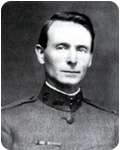 William's Bio William's Bio
When Burr Ozment resigned his leadership with the Manhattan Municipal Band, the band board chose Sgt. William Illingsworth as his successor. Illingsworth had recently retired from active duty as a band leader in the United States Army. William Illingsworth was born in Yorkshire, England and when his family chose to leave their native country they ultimately settled in the Junction City, Kansas area. In December, 1895 Illingsworth enlisted as a trumpet player in the band of the First Regiment, United States Cavalry. He remained a musician in the U.S. Army until his 1921 retirement (he re-enlisted one year later, retiring for good in 1924). During World War I he held responsibility for training bands for service in Europe, producing, on average, one complete band every three months. Illingsworth settled with his wife Grace in Manhattan in 1921 and taught in the Military Science Department of KSAC, directing the ROTC band, and was also assistant director of the College band. He was very enthusiastic about taking over the reins of the Manhattan Municipal Band, but his tenure in the position was short-lived. Illingsworth and his wife left Manhattan in 1925 for Anaheim, California, where they planned to farm land they'd purchased. Unfortunately, he became very ill and disabled with tuberculosis, and on December 21, 1928 William Illingsworth passed away. |
| Clarence P. Howenstine | (1888-1963), Director 1923 | | |
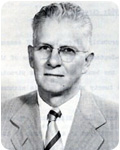 Clarence's Bio Clarence's Bio
Nicknamed "Stine," Clarence Howenstine had helped found the Manhattan Municipal Band, served for one season as the organization's director, and played baritone in the group. He came from a musically inclined family from Ohio. Once they relocated to Manhattan, Kansas, the entire Howenstine family would regularly gather in the evenings to collectively play their instruments together. Clarence, along with two of his six siblings went on to graduate from Kansas State Agricultural College. After leaving college, Clarence went into the printing business. He worked for a time at the Manhattan Mercury and then went to the Collegian, the campus newspaper at KSAC. Howenstine directed the Manhattan Municipal Band for one season and stayed on as assistant conductor as necessary after Harry Brown was appointed director in 1924. When he wasn't acting in this role he still played baritone horn in the group. |
| Robert Henry (Harry) Brown | (1876-1949), Director 1924-1948 | | |
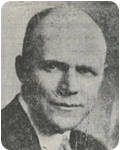 Harry's Bio Harry's Bio
As former director William Illingsworth came to Kansas from his native Britain, the Brown family came to the Midwest from Edinburgh, Scotland. They moved to Manhattan in 1886 when Harry's father, Alexander Beethoven Brown assumed the position as head of the music department at KSAC. Harry attended schools in Manhattan and Leavenworth, Kansas, graduating from Leavenworth High School and enrolling in the mechanical engineering program at Kansas State in 1894. While a student at Kansas State, Harry built what is believed to have been the first automobile in Manhattan. The logical question is just how someone with this sort of background assumed a musical path in life. When his father's health failed, Harry assumed some of his classes as a substitute instructor and went on to graduate in music with honors. Then, in 1898, Harry went to Chicago Musical College for post-graduate studies. He then returned to Kansas State as an Assistant Instructor and taught violin and wind and percussion instruments and directed the band. Five years later he was promoted to Assistant Professor and took over the university's orchestra as well. In 1919 Brown resigned from Kansas State to accept a sposition as director of music in the Kansas City, Missouri Public Schools, but returned to Manhattan three short years later when he purchased the Smethurst Music Company at 429 Poyntz Avenue, renaming it the R.H. Brown Music Company. He also took a position as conductor of the pit orchestra for silent movie showings at the Wareham Theater. In July, 1923, the Manhattan Board of Education proposed combining the Municipal Band Director position with that of the school instrumental music teacher, and so Harry Brown became that person. When Clarence Howenstine's contract expired at the end of the 1923 season, Harry Brown became the new director of the Manhattan Municipal Band and the teacher of all winds and strings in the Manhattan Public Schools. He continued in this duel role until his retirement from the public schools in 1946. Harry Brown expanded the band from its original size of 16-20 players to 45-50 players and helped to augment the band's library of music. Brown also undoubtedly helped the band to improve its overall quality of performance. He was given the Kiwanis 1939 Distinguished Citizen of Manhattan Award. The slogan he had printed atop the band's letterhead in 1930 was Making Classical Music Popular. Due to poor health, Harry Brown resigned as director of the municipal band in February, 1949 and died on August 24 of that same year. His successor, Rex Conner dedicated the concert of the week of July 20, 1949. |
| Rex Alton Conner | (b. 1915), Director 1949 | | |
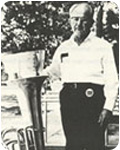 Rex's Bio Rex's Bio
Rex Conner was born into a farming family in 1915, and after graduating from high school in McPherson, Kansas moved to Emporia to attend Kansas State Teachers College. In 1936 Connor transferred to the University of Kansas in Lawrence, where he earned his Bachelors Degree in Music Education in 1938. He immediately accepted a position teaching instrumental and vocal music in Glasco, Kansas. In 1942, Conner enlisted in the United States Army Air Corps as a bandsman. He served in Arizona dn in Germany and was discharged in 1946. He moved with his wife Alberta to Manhattan in the fall of 1946 and succeeded Harry Brown as instrumental music teacher in the Manhattan Public Schools. He held this teaching position through the 1948-49 school year. After the 1949 season Conner moved to Columbia, Missouri to work on his master's degree in music education. From there he joined the faculty at Wayne State Teachers College in Wayne, Nebraska and then the University of Kentucky, where he retired in 1980. |
| Larry Norvell | (b. 1920), Director 1950-1995 | | |
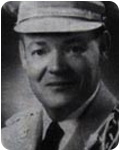 Larry's Bio Larry's Bio
One name comes to nearly everyone's mind when the Manhattan Municipal Band is mentioned; Lawrence (Larry) Norvell. Mr. Norvell was appointed conductor of the band on February 7, 1950 and by the time he retired the post had led the band longer than all of his five predecessors combined. Norvell was born in Boston, where his father Phillip was attending the Boston Theological Seminary as a Methodist ministerial student. At that time, the Methodist Church held a policy of moving its ministers from congregation to congregation at approximately two-year intervals. Consequently, the greater part of Larry's childhood was spent moving from city to town in Colorado. In the fourth grade Larry began playing the E-flat alto horn and played in his various school groups. He ultimately graduated from Topeka High School in Kansas in 1938 and enrolled that fall at Kansas State Teachers College in Emporia. When the second world war broke out, Norvell enrolled in officer's training with the United States Navy. He graduated from KSTC in 1943 with a Bachelor of Science degree in music. That same year, while living in Eureka, Kansas with his parents and awaiting his call to military duty, Norvel signed a contract to replace the town's school band director, who had just been drafted. Unfortunately, after only one week in the position Norvell's own military orders arrived and he was forced to resign. Knowing that he had a background in music, the Navy assigned him to training as a sound and communications officer and he eventually served with the third and fifth fleets in the South Pacific. In 1946, after finishing military service, Norvell began teaching music in Moran, Kansas. Three years later he moved with his wife Joy and the first of their four children to Manhattan. He became director of the Manhattan high school band and orchestra and also taught the junior high school choir. For more than thirty years, Larry Norvell provided steady and honorable leadership to the Manhattan Municipal Band. Not only did the size of the band increase under his baton, but so too did the caliber of their performances. It was Larry Norvell who was behind the 1962 construction of Manhattan's current band shell and we are very proud to name the rennovated facility after this icon of musical life in Manhattan. |
| Frank C. Tracz | (b. 1956), Director 1995-present | | |
 Frank's Bio Frank's Bio
Dr. Frank Tracz is Professor of Music and Director of Bands at Kansas State University in Manhattan, Kansas. At K-State he coordinates undergraduate and graduate conducting activities, teaches classes in music education, and administers and guides all aspects of the K-State band program, which includes the Wind Ensemble, Concert Band, University Band, Athletic Pep Bands, and Marching Band. Under his direction the Wind Ensemble has performed at the Kansas Music Educators Association Conference, the MENC National Conference, A CBDNA regional Conference, as well as regional and international tours. Under his direction, the “Pride of Wildcat Land” Marching Band has enjoyed the privilege of traveling to nationally acclaimed bowl games in support of the University. When Dr. Tracz first came to Manhattan he played in the percussion section of the Manhattan Municipal Band, still under the baton of Larry Norvell. Since he has taken the podium of the band, the band has continued to grow, not only in numbers -- presently over seventy-five musicians -- but also in its level of performance and its involvement in the greater Manhattan community. Read More Dr. Tracz received the Doctor of Philosophy (music education) from The Ohio State University, a Master of Music degree from the University of Wisconsin-Madison, and a Bachelor of Music Education degree from The Ohio State University. Dr. Tracz has several years experience teaching in the public schools of Ohio and Wisconsin. He has also served as Assistant Director of Bands at Syracuse University. Prior to his appointment at K-State, he was the Director of Bands at Morehead State University in Morehead, Kentucky.
He has served as an adjudicator, clinician and guest conductor for all-state and honor bands across the nation, as well as in Canada and Singapore. Dr. Tracz is on the Faculty Board and a frequent clinician for the Conn-Selmer Institute at Notre Dame as well as a past member of the Music Education Journal Editorial Board and is a contributor to the series Teaching Music Through Performance in Band. He also researched and developed a Master of Music Education program that is now in place at K-State. In addition to being an inducted member of the Golden Key National Honor Society, he is a member of Pi Kappa Lambda, Phi Beta Mu, and Pi Lambda Theta. In March of 2012 he was elected to the prestigious American Bandmasters Association. He currently serves as the advisor for the Kansas State chapters of Kappa Kappa Psi, Tau Beta Sigma and the K-State Band Ambassadors. Dr. Tracz is Past President of the Big XII Band Directors Association, Past President of the Kansas Bandmasters Association, and Director of the Manhattan Municipal Band. Dr. Tracz has been honored with the prestigious Stamey award for Outstanding Teaching, and recognized as a Mortar Board Outstanding Faculty Member, and participates in the K-State Presidential Lecture Series. In 2007, Dr. Tracz was inducted in to the Mortar Board Senior Honor Society and was recognized by The Women in Engineering & Science Program for his outstanding contributions to the university. Additionally, he was honored with the Outstanding Bandmaster Award from the Kansas Bandmasters Association and Phi Beta Mu. In December 2006, Dr. Tracz was honored by being named a Lowell Mason Fellow by the National Association of Music Education. Recently (2011) he was awarded the First Annual Wildcat Pride award by the K-State Alumni Association, and the Tau Beta Sigma Paula Crider Outstanding Band Director Award. Dr. Tracz was also recently elected to the prestigious American Bandmasters Association in February of 2012. |
 Burr's Bio
Burr's Bio William's Bio
William's Bio Clarence's Bio
Clarence's Bio Harry's Bio
Harry's Bio Rex's Bio
Rex's Bio Larry's Bio
Larry's Bio Frank's Bio
Frank's Bio